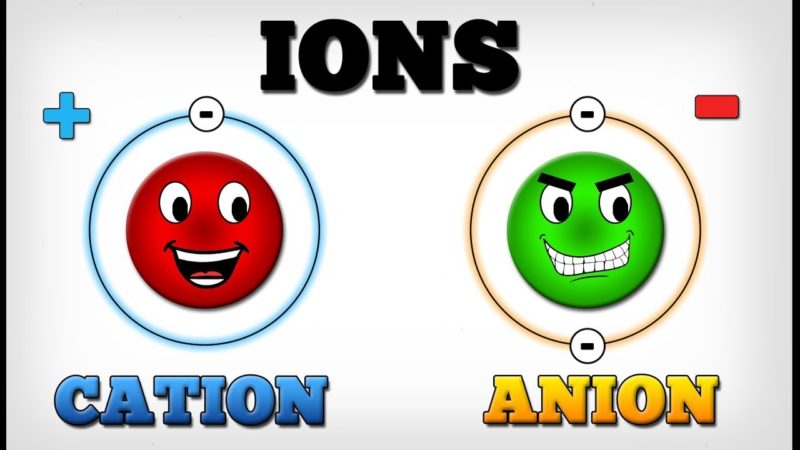What is the difference between cation and anion?
Cation and anion are both ions. These two terms tend to cause confusion among many learners and it is quite important to know the core difference.
The lesson provides a core difference between cations and anions both in tabular and point form. Remember also to read through the characteristics of these ions for deeper understanding.

What Is A Cation?
A cation is an ion that tends to carry a positive charge and they are formed from metals. It normally tends to attract negative electrodes during electrolysis. Cations occur when an atom donates an electron.
The main aim of donating electrons is to foster stable noble gas configuration. Examples of cation metals include Beryllium (Be2+), Ammonium (NH 4+), Potassium (K +), and Barium (Ba2+) among many others.
Main Features of Cations
- They are positively charged ions
- Tend to have more protons than electrons
- Are formed after the metal loses some electrons
- The net positive charge is indicated with a superscript + after the molecular formula
- They tend to move towards negative electrodes during electrolysis
- They are listed before anion after the formation of the ionic compound when writing their symbol.
What Is An Anion?
An anion is a negative charge ion and they are formed from non-metals. They are formed by gaining an electron.
These ions are normally attracted to the positive electrode during electrolysis since they contain a net negative charge.
Examples of anions include Iodide (I-), Hydroxide anion (OHˉ), Chloride (Cl-), Hydroxide anion (OHˉ), Fluoride (F-), Nitride (N3-) and Bromide (Br-) among many others.
Main Features of Anions
- They are negatively charged ions
- Tend to have more electrons than protons
- Tend to be formed from non-metal atoms
- Are formed when non-metal gain electrons
- Negatively charged anion has a negative superscript
- Tend to move towards anodes during electrolysis
- Are listed after cation when writing the molecular formula
Comparison Chart: Cation vs Anion
| Basic Terms | Cation | Anion |
| Meaning | Are positive charge ions that lose an electron to attain a noble gas configuration | Are negative charge ions that gain an electron to attain noble gas configuration. |
| Protons Vs Electrons | It has more protons than electrons. | Has more electrons than protons |
| Formation | They are formed when a metal atom loses some electrons | They are formed when a non-metal atom gain some electrons |
| Charge Indicator | The net positive charge is represented by a superscript + e.g Be2+ | The net negative charge is represented by a superscript – e.g OHˉ |
| During Electrolysis | Tend to move towards the cathode electrode | Tend to move towards the anode electrode. |
| How to write the Molecular Formula | The cation is listed before anion such as MgCl | The anion is listed after cation such as FeCl |
| Examples of Ions | Beryllium (Be2+), Ammonium (NH 4+), Potassium (K +), and Barium (Ba2+) | Iodide (I-), Hydroxide anion (OHˉ), Chloride (Cl-), Fluoride (F-), Nitride (N3-) and Bromide (Br-) |
| Compounds Formed | Cation combined with an anion to form an ionic compound | Anion combined with cation to form an ionic compound |
| Electrostatic Interactions | Form electrostatic interaction with an anion to form an ionic compound | Form electrostatic interaction with cation to form an ionic compound |
Core Differences
- Examples of cations are Iron (Fe2+), Sodium (Na+), and Lead (Pb2+) while examples of anions are Fluoride (F-), Bromide (Br-), Iodide (I-), Nitride (N3-) and Hydride (H-).
- Cations get attracted to the cathode during electrolysis while anions get attracted to anode during electrolysis.
- Cations are positively charged and they are formed from metal atoms while anions are negatively charged and they are formed from non-metal atoms.
- Cations tend to have more protons than electrons while anions tend to have more electrons than protons.
You May Also Like:
- Difference between Atom and Molecule
- Difference between Solute and Solvent
- Difference Between Compound and Mixture
- Difference between Concentration and Density
- Difference between Static and Dynamic Equilibrium
Comparison Video
https://youtu.be/6OxRB9ShoHw
Conclusion
Cations and anions are some of the common terms used in chemistry. They tend to have some similarities like the presence of neutrons, protons, and electrons.
Understanding the difference between cation and anion is key when studying chemistry. The article provides a deeper insight into the distinction.
More Sources and References